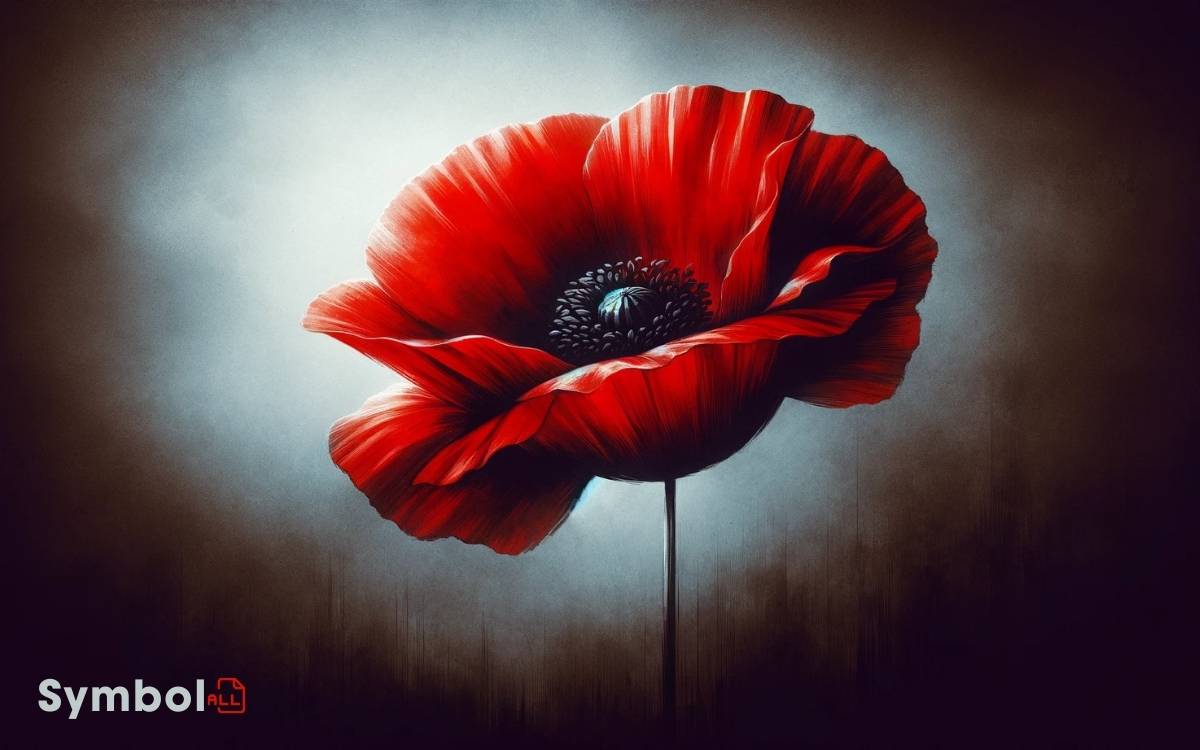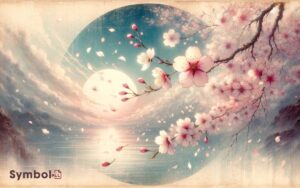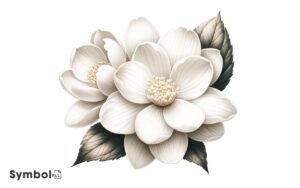What Does Poppy Flower Symbolize? Remembrance!
You’ll find the poppy flower embodies a diverse range of symbolism. Its bright red color is closely tied to remembrance and peace, significantly representing fallen soldiers and serving as a universal symbol of longing for peace.
Historically, poppies were linked to sleep and oblivion, a nod to their narcotic properties that induce forgetfulness.
Additionally, they carry potent symbolic associations with fertility, resurrection, and wealth, indicating prosperity, success, and the cycles of nature.
The flower also holds a place in various mythologies, signifying themes of immortality and eternal sleep. Unraveling these layers offers deeper insights into its rich symbolic meanings.

Key Takeaways
Historical Significance
The poppy flower has held significant cultural and historical roles across various civilizations. It serves as a symbol of both remembrance and opulence due to its psychoactive properties and vivid appearance.
Historically, its cultivation dates back to ancient civilizations, where it was revered not only for its beauty but also for its medicinal and recreational uses.
The Sumerians, for instance, referred to it as the ‘plant of joy,’ highlighting its capacity to alter human consciousness.
Its opium derivative was widely utilized in ancient medical practices for pain relief and sedation, underscoring the plant’s dual nature as both a source of pleasure and a medicinal aid.
This duality fostered a complex relationship between humans and the poppy, intertwining its allure with its potency, thereby cementing its historical significance.
Remembrance and Peace
Poppy flowers symbolize remembrance and peace, serving as poignant reminders of those lost in war and conflicts across the globe. This symbolism is deeply rooted in the plant’s biological and ecological characteristics.
For instance, the poppy’s resilience, as it blooms in disturbed soils, mirrors the human capacity for recovery and peace after devastation.
Scientifically, the genus Papaver, to which poppies belong, exhibits unique alkaloids like morphine and codeine, historically used for pain relief, metaphorically offering solace in times of sorrow and conflict.
The flower’s vivid red color further underscores its symbolism, representing the bloodshed of fallen soldiers.
By blending botanical attributes and historical context, poppies serve as universal symbols of remembrance and a longing for peace, embodying a deep-seated human desire to honor sacrifice and aspire towards harmony.
Mythology and Immortality
In various mythologies, poppy flowers embody themes of immortality and eternal sleep, intertwining with tales of gods and mortals alike.
These flowers are not just botanical entities but carry profound symbology within ancient narratives, serving as emblems of life’s cyclical nature and the promise of rebirth.
Their appearance in mythological stories often signifies a bridge between the earthly world and the divine, illustrating a deep-rooted association with the supernatural.
| Culture | Significance |
|---|---|
| Greek | Associated with Demeter, symbolizing fertility and renewal. |
| Egyptian | Linked to Osiris, representing resurrection and immortality. |
| Norse | Seen as a tribute to Freya, indicating enchantment and prophecy. |
This table encapsulates the flower’s multifaceted roles across different mythologies, highlighting its connection to immortality through symbolic representation of divine attributes and eternal cycles.
Sleep and Oblivion
Beyond their mythological connections to immortality and divine attributes, poppy flowers also symbolize sleep and oblivion, reflecting their potent narcotic properties and their role in inducing a state of forgetfulness.
This symbolism is deeply ingrained in their biochemistry, primarily due to the presence of alkaloids such as morphine and codeine, which have profound sedative and analgesic effects.
These compounds interact with the human nervous system, specifically binding to opioid receptors, thereby reducing pain perception and promoting sleep.
Consequently, poppies have been emblematic of not just physical sleep, but a metaphorical journey into the domain of forgetfulness and oblivion, offering an escape from the troubles and memories that tether one to reality.
This dual symbolism showcases the poppy’s complex nature, intertwining life’s fragility with the allure of an eternal rest.
Fertility and Wealth
You’ll find that poppy flowers carry profound associations with fertility, rooted in ancient cultures where their seed-producing capacity symbolized abundant life.
The symbolism extends to wealth, as the flower’s vivid blooms and opulent seed pods have historically denoted prosperity and success.
Comparing cultural interpretations reveals a nuanced understanding of how these themes of fertility and wealth have evolved alongside human civilization, offering insights into the flower’s enduring significance.
Ancient Fertility Associations
Historically, poppy flowers symbolized fertility and wealth, playing a significant role in various ancient cultures’ agricultural and economic practices.
You’ll find that these flowers weren’t merely admired for their beauty; they held deeper, more practical implications.
Ancient societies, understanding the cycle of life and death, recognized the poppy’s capacity for both nurturing and destructive forces.
Its seeds, capable of lying dormant for years before blossoming abundantly, embodied the concept of potential life awaiting the right conditions.
This characteristic mirrored human fertility, where the potential for new life exists, contingent on various factors.
Consequently, poppies became emblematic of the hope and promise for future generations, illustrating a profound appreciation of the cycles of nature and their implications on human existence and prosperity.
Wealth Symbolism Explained
The symbolism of the poppy flower as a wealth indicator is deeply rooted in its association with agricultural abundance and economic prosperity.
Historically, regions with fertile soil conducive to the cultivation of poppies often experienced a surge in wealth, due to the dual utility of poppies for both culinary and medicinal purposes.
This economic boon wasn’t merely coincidental but stemmed from the plant’s inherent characteristics. Poppies can thrive in varied climates and soils, making them a reliable source of income.
Additionally, the poppy’s resilience and its ability to regenerate symbolize not just transient wealth, but a sustainable prosperity.
Analyzing this from a scientific perspective, the correlation between poppy cultivation and economic stability is evident, underscoring the flower’s role as a symbol of wealth beyond its aesthetic value.
Cultural Interpretations Compared
Exploring the poppy flower’s symbolism further reveals nuanced interpretations across cultures, particularly in the domains of fertility and wealth.
- In ancient Greek mythology, poppies were associated with Demeter, the goddess of agriculture and fertility, symbolizing the promise of bountiful harvests.
- The Chinese view poppies as emblems of beauty, success, and wealth, integrating them into art to represent material and spiritual prosperity.
- In Egyptian culture, poppies symbolize fertility due to their prolific seed production, linking them to life’s renewal.
- Victorian England interpreted poppies as a sign of wealth and extravagance, reflecting an era’s fascination with opulence.
- Eastern European folklore often celebrates poppies in wedding ceremonies, symbolizing fertility and the hope for a prosperous union.
Each interpretation enriches our understanding of how poppies weave into the cultural fabric, embodying complex themes of fertility and wealth.
Modern Interpretations
In contemporary contexts, poppy flowers symbolize a range of emotions and ideas, from remembrance and mourning to peace and sleep, reflecting their diverse cultural significances.
You’ll find that these symbols are not static; they evolve with societal changes and new scientific insights.
| Color | Symbolism | Modern Interpretation |
|---|---|---|
| Red | Sacrifice | Remembrance of fallen soldiers |
| White | Peace | Hope for tranquility and end of conflict |
| Purple | Mourning | Respect for the deceased and empathy for loss |
| Yellow | Wealth | Aspiration for success and happiness |
| Black | Sleep | The scientific association with opium and its sedative effects |
This table encapsulates the multifaceted meanings of poppy flowers in today’s world, offering a deeper understanding of their relevance across different contexts.
Conclusion
In the grand tapestry of symbolism, the poppy flower emerges as a veritable titan, dwarfing mere mortal concepts with its profound meanings.
You’ve journeyed through its historical roots, where it stands as an immortal sentinel of remembrance and peace, to the mythological domains where it whispers secrets of immortality.
Its petals, steeped in the elixir of sleep and oblivion, unfurl into a universe where fertility and wealth are but a shadow of its true power.
In modern interpretations, it transcends, becoming an emblem not just of what is, but of all that could be.
The poppy, in its ethereal elegance, encapsulates the essence of life’s paradoxes—offering a beacon for those willing to explore into its depths.






